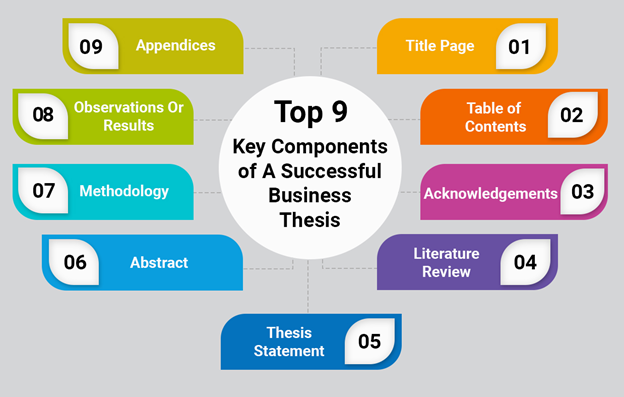The business thesis is greatly beneficial for the evolution and development of industries. By exerting research efforts, entrepreneurs can estimate which part of the current process is working well and which changes are required. You can make the necessary improvements by identifying the problem area from the knowledge you gained from the literature study.
Writing a thesis may require students to analyse and evaluate complex data. Synthesising such information cohesively may be a hard nut to crack. Therefore, it is essential to learn about the key components of the thesis if you want to build the bridge of task complexities. The inclusion of these key components may help you in writing a top-notch paper. Keep reading to polish your thesis for the fine quality.
Top 9 Key Components of a Successful Business Thesis
You must be at the end of your degree, where you are looking at the basic guidelines for writing your master’s thesis. It is because you were deeply involved in learning coursework and passing exams when, suddenly, the idea of research sprang up from somewhere. If writing such projects is challenging as you are new to such types of academic projects, then acquire assistance from UK-based thesis writing companies to get quality papers written by experts.

However, if you want to write it yourself, this article will highlight all the things that you must keep in mind as you hold the pen. Here are the key components to go over.
1. Title Page
The reader should be able to get information about the business thesis with just a glance. Your thesis title page will play this role. Depending on the university or journal guideline, there is a specific format for designing the title of the thesis.
However, some general guidelines can be followed.
What Should Be the Format of The Title Page?
- It should succinctly summarise the main idea.
- Don’t use any abbreviations in the title.
- It must be written in the title case.
- Make it bold, centred and place 3,4 lines down the top margin.
- There should be a double place between the title and bylines.
2. Table of Contents
It is an index of the thesis business that acts as a skeleton. Just like a skeleton holds all body organs, the table of contents will organise your arguments in the thesis. It includes sections and subsections in the proper order as it occurs in the thesis.
What Is the Purpose of a Table of Contents?
- It gives the reader an overview of the topic.
- The reader can quickly navigate and locate the information.
- It saves time and effort for the reader to learn about the business thesis research topic.
- It gives a sense of order.
- It encourages you to properly use headings and subheadings.
3. Acknowledgements
The thesis for business writing journey may be arduous as it is a long story of unending struggle. This strenuous process is overarching to cross it on your own. However, different people give you a helping hand on the way to take off some stress. They may be your peers, professors, seniors, classmates, parents, etc. contributing with emotional, physical or financial support.
Therefore, as you wrap up the journey, it’s a good sign to acknowledge the participation of all contributors.
Here are the tips for writing meaningful acknowledgements in business thesis.
- Be specific instead of using generic phrases.
- Stick to the specific instructions as given by the institution.
- There should be an easy-to-follow hierarchy.
- Don’t use colloquial expressions but show professionalism.
4. Literature Review
The literature review chapter discusses the published information on your topic of discussion. It can just summarise all the sources you consulted for the data collection. You need to synthesise and reorganise the information for its better interpretation. This chapter might track the intellectual progress of the field.
Strategies for Writing the Literature Review
- Pick up one business thesis theme and be focused on it.
- Use simple statements and tell the reader what is your main organising principle.
- Use several sources to support your arguments and prove that you are telling the truth.
- The information you use should directly relate to the focus point.
- Use quotes sparingly that are coined by the author, not common language.
5. Thesis Statement
A thesis statement shows what your business thesis is about. It will tell the reader how you will interpret the subject under discussion. Consider it like a road map for the reader’s expectations about the long document. It is usually a single statement, part of the introduction chapter.
How To Estimate If Your Thesis Statement Is Strong?
- If it answers the main question.
- If it takes the position that others might challenge or refute.
- It should be specific enough rather than vague.
- If your thesis statement and body paragraphs go together.
- It should address the “how” and “why” questions.
6. Abstract
The abstract is like a summary of your business thesis that gives the reader an idea about what you will be covering in it. By getting the essence of the paper, the reader may decide whether they should continue reading or not. It will prepare for the detailed information, arguments and analysis in the full paper.
If it is difficult to craft your abstract, you must hire a thesis writer instead of making mistakes on your own. Else, you need to learn what information you should insert in your thesis abstract.
What Kind of Information an Abstract May Provide?
- The background of your research work.
- It states the main research question.
- It describes what’s already known about the topic.
- It defines the significance and implementation of your work.
- This part covers all the key components of your paper such as findings, results, arguments, methodology, etc.
Business Thesis Examples
The University of Edinburgh provides an example of a thesis written on the topic “The Double-Edged Sword of AI & Big Data: A Socio-Technical Examination of Fairness in
Alternative Lending”. The paper’s abstract is given below.

7. Methodology
A methodology is an overarching rationale that you use for your business thesis research project. It defines how you collect and analyse the data to draw results. The method you choose must be appropriate to your field of study and can specifically address the main research question.
What Are the Features of a Good Research Methodology?
- It should be conducted impartially.
- It must involve a structured and organised process of data collection and interpretation.
- It should rely on empirical evidence.
- You can document it in a way so that other researchers can easily replicate it.
- It should easily be applicable beyond a specific context.
- The research should be conducted in an ethical manner abiding by the specific ethical considerations.
8. Observations or Results
This is one of the most important parts of your business thesis where you come up with the results to support your main question. It will concisely describe what you have observed and measured throughout your study. Therefore, all the findings are aligned logically.
What Should the Results Section Include?
- It must include all the relevant tables, and figures.
- It will present all the secondary findings.
- Must describe all the results even if it does not fit into your assumptions.
- For the quantitative method, you will categorise the themes or data by coding.
- For the qualitative method, present the findings from statistical analysis.
9. Appendices
All the extra information or subsidiary data must go in the appendix section. For instance, it may contain material like tables, figures, examples, computer programs, interview questions, raw data, etc. All such data should be labelled concerning its placement in the body text.
How To Formate Appendix of Your Thesis?
- The appendix title will be formatted like any other chapter title.
- If there is more than one appendix in a business thesis, it can be numbered as A, B, C, etc.
- The page number of the appendix must continue the main text.
- You must include the IRB approval letter along with your appendix.
- You should not include the author’s biography along with your thesis.
Business Administration Thesis Topics
The field of business administration is continually evolving. The researchers may opt for the advanced topic to add innovation in the field. Here are some potential topics to consider in this regard.
- Analyse the impact of analytics in decision-making about a business.
- What is the role of artificial intelligence in marketing a business?
- What is the role of social media in building the reputation of a brand?
- Investigate the role of machine learning in fraud detection.
- How artificial intelligence can help in talent management.
- Investigate the role of data analytics in sustainability management.
Conclusion
A business thesis is a major milestone to achieve in your academia. Many students find it challenging to write this document as it involves various writing or structural technicalities. Therefore, buying a thesis online from experts can be a viable solution to mitigate all the writing challenges. However, if you are aware of the basic components of the thesis, the writing process becomes a little easier.
In the guide above, we had a detailed discussion on the key components of the thesis. All the related concerns of the students have been addressed well so that there should not be any ambiguity. So, any researcher who is looking for a guide to write their thesis, this article can prove valuable. Write your findings coherently in the document so that you may get good grades that can keep you ahead of the competition.

